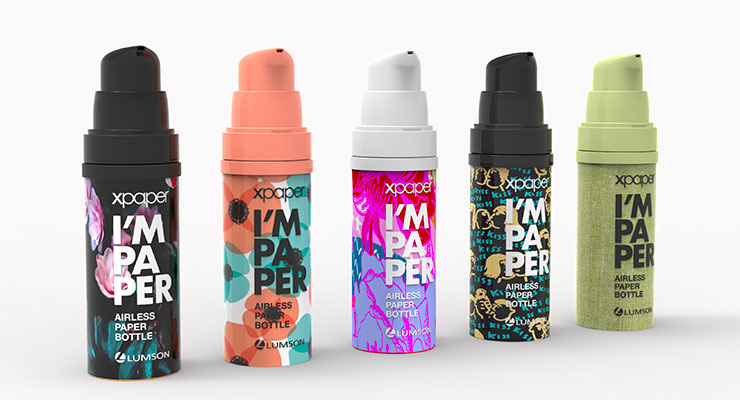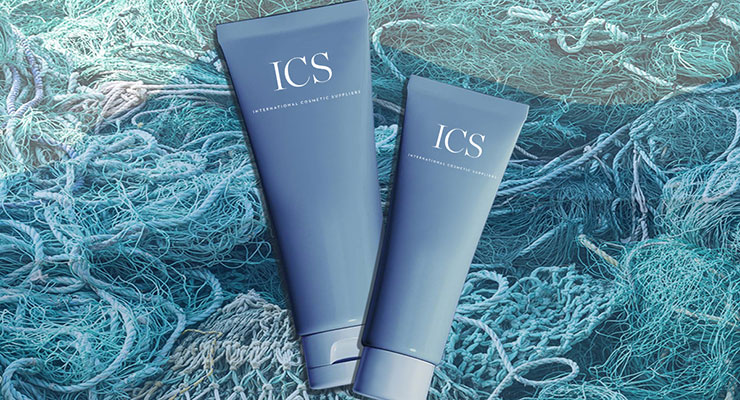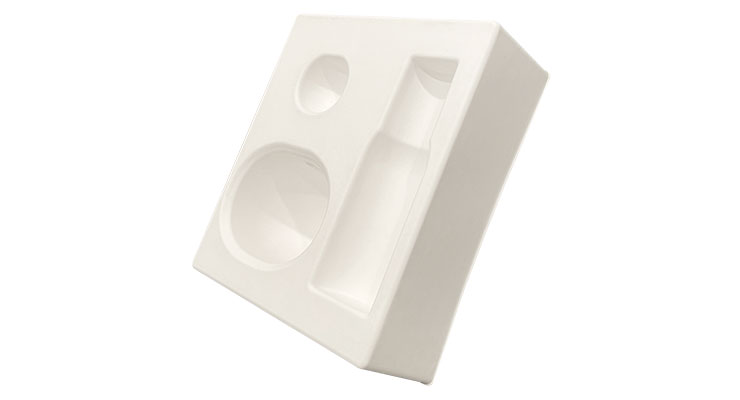Joanna Cosgrove, Contributing Editor02.03.22
As the path forward in sustainable packaging accelerates, beauty brands are progressively seeking creative materials that can make a difference.
New types of innovative materials are being explored. Beauty brands are modernizing their packaging with new types of materials—including molded pulp, paper and reclaimed ocean plastics.
We spoke to several suppliers offering these new materials.
Sourcing Eco-Friendly Paper, Pulp & Plastics Will Make a Difference
Worldwide, experts are offering predictions on which solutions will spark the greatest impact.The demand for paper, pulp, and plastics is on the rise—especially for more sustainable versions of these materials. (Note: Wallpaper recently explored some of these new materials in the article, "Are biomaterials the future of beauty packaging?")
- In the paper realm, Fortune Business Insights expects the global paper and board segment to grow in volume and value due to shifting consumer perspectives.
- In a similar vein, Grandview Research reports demand for molded pulp packaging (think egg cartons) is also poised to grow. This is due to an increased demand for sustainable packaging solutions and stringent plastic regulations, with non-wood sources like grasses, cereal straw, sugar cane bagasse and reeds, expected to drive innovation.
- On the plastics side, The Pew Charitable Trusts estimates 11 million metric tons of plastic are dumped in the ocean each year, and says we’re on track to triple this amount by 2040 unless large-scale countermeasures are implemented.
- Currently, 95% of plastic packaging qualifies as single-use, according to Pew, and although many packaging suppliers offer recycled/PCR resins and plastic alternatives, Pew says we’re still collectively losing the battle.
Eco-Friendly Plastics—Suppliers Offer More Sustainable Solutions
The good news: Enterprising packaging suppliers are trying and succeeding with novel approaches to solving the problem.Roberts Beauty offers beauty brands Oceanworks Guaranteed resins.
Roberts Beauty has fully vested in post-consumer recycled plastics, having partnered with Oceanworks to responsibly source all the recycled ocean plastic used to create its Oceanworks Guaranteed resins.Kristen Corso, Roberts Beauty’s vice president of marketing, says Oceanworks’ global materials network is backed by shore-to-shelf traceability and an Oceanworks Guarantee whereby resins are independently validated by third party testing to be contamination-free and sourced in compliance with international standards for business, environmental and fair labor practices.
Corso says these resins help reduce the effects of man-made waste on sensitive ecosystems, have extremely high purity levels when re-processed, and can be re-recycled in the recycling stream multiple times. “There’s no green-washing here, traceability is certified and documented from the collection origin site to the manufacturing location,” she explains.
“The brand can tell the individual stories about their particular batch of Oceanworks Guaranteed resin and the consumer gains confidence knowing the origin story of their purchase, which they are now giving a second life.”
Roberts Beauty is finalizing a new customer collection made from Oceanworks Guaranteed resins that’s slated for launch on Earth Day later this year.
Plastube sources ocean bound resin and produces bkind's tubes.
At Plastube, demand for tubes made from recycled resin is on the rise.Stephane Beauchemin, the company’s vice president of sales and marketing, says it’s becoming more common for brands to make the use of recycled resin mandatory.
Plastube’s resin is sourced from an ocean bound resin manufacturer that uses “material at-risk of becoming ocean pollution and turn[ed] into a reliable plastic resin.” The plastic used by Plastube was the first to be granted a Letter of No Objection (NOL) by the FDA to create food packaging from recycled ocean bound plastic.
Ocean bound plastic requires no special handling processes, but Beauchemin says it does have some noticeable differences in comparison to virgin polyethylene. For starters, its color is not inherently as white, and because it contains shredded resin the feel is also slightly grainier, which he says can be an asset, depending on the application and target customer.
Plastube offers COEX tubes that contain 45% recycled resin (on the inner layer of the tube) and deliver a tactile experience very similar to regular virgin polyethylene tubes.
Plastube worked with beauty brand Bkind to create a skin cream tube that echoed the brand’s all-natural ethos. The tube is a 39x150 mono-material containing a mix of ocean bound plastic (50%) and HDPE (50%) resins with an octagonal cap and offset decorative printing.
International Cosmetic Suppliers Ltd. (ICS) recently expanded its range of sustainable packaging material options to include HDPE Ocean Plastics made from sustainably sourced, recycled HDPE from fishing nets, ropes and trawls pulled directly from the maritime industry.
Its latest offering is a sustainable, multi-layer, 13mmD – 50mmD tube with an HDPE Ocean Plastic outer layer and virgin PE inner layer that’s REACH and Proposition 65 compliant.
“Just like virgin plastic tubes, ICS Ocean Plastic tubes are suitable for a variety of printing options, such as offset print, silkscreen and hot stamp, as well as finish options, such as glossy, matte and soft touch,” says ICS’s Eleanor Bunting, marketing and communications manager, noting that the tubes are easily recycled to help give packaging a longer lifecycle.
Shenzhen Beauty Star describes challenges—but says ocean bound plastics are beauty's most important asset.
Moonoy Ouyang, minister of marketing at Shenzhen Beauty Star, says that although there are minor caveats to working with ocean bound plastics, she’s confident that the growing impact of global plastic pollution will compel packaging providers and brands to act in increasingly forward-thinking ways to combat the problem.One challenge is cost, others involve continually refining production processes. “Current costs associated with ocean bound plastics are more expensive than virgin and standard PCR-type plastics,” says Ouyang, noting mechanical performance can also be impacted through physical recycling due to corrosion from sea water salinity.
She explains, “If it is recycled by physical method, it will cause black spots, pits, unpleasant smells and a different color of recycled products, or cause more bad printing and partial loss of mechanical properties. These bad items can only be alleviated by continuous optimization of production process but cannot be completely eliminated.”
Ouyang concludes that ocean bound plastics are one of the packaging industry’s most important assets for protecting the environment.
“Consumers…are more willing to accept environmentally conscious packaging [and] we believe that more brands and products will use OBP materials,” she says.
Suppliers Offer Pulp & Paper Innovations
Molded fiber, made from molded pulp, is an eco-friendly material that offers beauty brands a creative solution to sustainable packaging issues.Molded fiber is not a new material, but its texture and sustainable story have helped it become a popular option for primary and secondary packaging. It’s inherently cost effective (compared to plastics), offers a reduction in raw material and tooling costs, and minimizes transit costs due to its light weight.
NF Beauty Group offers molded fiber and pulp-based packaging, which offer beauty brands numerous advantages.
NF Beauty Group anticipates an increased demand for paper pulp-based packaging in the next two to three years because of its advantages.“Paper pulp provides an opportunity for secondary packaging that many laminated and highly decorated paper board products cannot provide due to the heavy coating and layers,” comments Andrea Greff, industrial designer.
“Paper pulp presents the ability to recycle without clogging up the recycling stream with glues and dyes, as long as it has been separated from any Styrofoam or protective lining. [It can be] placed in compost when necessary,” Greff says.
Because paper pulp can be prone to tearing and rough surfaces, the tooling process is quite important. “When processing to create pulp into a protective pack, a designer or engineer must design the tool in three-dimensional shapes,” says Greff. “This means paper pulp packaging requires tooling. Typical paperboard is only limited by the shape of two-dimensional die-cutters so this process can be both a challenge and an opportunity for brands.”
The cost of a paper pulp project depends on its complexity. “The rule of thumb is what you save (financially) on the assembly-line will be used in tooling with molded paper pulp,” she says.
“The tooling cost will be a three-dimensional steel or metal tool, so it requires 3D modeling and engineering—automated machine cutting steel, compression pressure, and edge finishing, but won’t require construction assembling as you’d see with die-cut paper board boxes or other paperboard packaging.”
Balance aims to help beauty brands replace plastics with bamboo and sugarcane pulp packaging.
Ceara Connolly, marketing manager, Balance Inc., contends molded fiber allows brands to play with volume while enhancing the overall experience for the consumer.Molded fiber from Balance Inc. is a sustainable mixture of replenishable bamboo and bagasse (a by-product of sugarcane waste—aka sugarcane pulp) that’s 100% recyclable and can be refillable and reusable.
“We are working hard at eliminating plastics by replacing them with paper and molded fiber [which] allows for the reduction of petroleum-based products,” Connolly says. “The molded fiber manufacturing process also has a system in place for the reuse of the water used throughout the manufacturing process.”
One of Balance Inc.’s most recent molded fiber applications is a molded fiber insert for a rigid, FSC certified paper box made for DKNY Holiday 2021. The insert allows three products to nestle safely inside.
Knoll specializes in molded pulp packages that can make a clamshell look luxurious—like it did for Chanel.
Knoll Printing & Packaging has seen demand for its Knoll Ecoform molded pulp grow steadily since its introduction in 2018.The company spent five years developing the solution to meet the aesthetics of this industry, and the resulting product is a “vegetable-based recipe” featuring Bagasse fibers (waste from sugarcane), bamboo and wood base fibers that’s FSC, recyclable (CEREC EN643 Norm) and biodegradable.
To celebrate the 100th anniversary of the N°5 perfume, Chanel partnered with Knoll Packaging to reinvent its packaging with a protective and sustainable, 100% Knoll Ecoform pulp clamshell.
The sleek, all-white clamshell is molded to echo the iconic shape of Chanel’s iconic N°5 perfume, and is biodegradable and recyclable in the paper and board recycling stream.
“Behind the purity and perfection of this design lies a high degree of complexity of both development and engineering to bring this unique shape to life,” says Ben Cohen, creative and innovation director, Knoll Printing & Packaging. “This project, which took over 18 months to develop, is not only an engineering feat, but also redefines the benchmark for sustainable luxury packaging.”
MAC also utilized Knoll Ecoform Molded Pulp for its 12-lipstick holiday set. “This packaging design itself is a double square split that can self-display on counters or in a customer’s home,” Cohen explains. “The construction requires a high level of expertise to allow the hinges to extend to the varying degrees, while maintaining the integrity of the box.”
Cohen says in 2022, Knoll will lean into growing demand for Knoll Ecoform Molded Pulp and eliminate 200 metric tons of plastic from its supply chain by implementing the product into its highest-volume ongoing projects.
“Our in-house sustainability department has conducted multiple Life Cycle Analyses on Knoll Ecoform…to…study the environmental impact of the material compared to the plastic and board versions of the same part,” Cohen explains.
“Our study has found that a Knoll Ecoform part emits upwards of 70% less CO2, as compared to the same part in plastic. Knoll Ecoform looks and feels like a paper-based product, so customers know it’s sustainable and how to recycle the package, and our customers are aware that it has less impact on the environment.”
Allta will debut 3D-texturing technologies for paper packaging at MakeUp in LosAngeles.
As a long-time proponent of the inherent sustainability of paper packaging, Allta has been leveraging its long history of turnkey paper packaging production.The company specializes in elevated applications with distinctive, artisan touches—including the recent turnkey production of stunning paper eye and face makeup palettes for Dito Cosmetics. The brand's design maximizes bold graphics and fashion-forward color.
David Berkman, CEO, says the company is also looking forward to MakeUp in LosAngeles, where it will debut new 3D texturing technologies like sparkle and flocking that were devised to give paper palettes fresh new looks.
Lumson created XPaper as an alternative to plastic or glass.
Lumson’s XPaper, a cardboard airless dispenser, garnered the 2021 ADI Design Index Award for Innovation.As part of Lumson’s Touchless packaging family, XPaper was created as an alternative to plastic or glass, but remains light, protective of the product and sustainable and customizable with conventional digital printing techniques. Once the package is empty, the dispenser can be separated from the bottle for easy recycling.
More Suppliers Explore New Avenues in Sustainability
Many packaging providers are investigating adding and expanding their presence in paper and reclaimed plastic packaging. For instance, SeaCliff Beauty already offers PCR packaging, and is working to improve sustainability with the enhanced traceability of ocean plastics.At General Fibre, the company’s patent pending Envirotray has been in development for over eight years as a paper solution to plastic vacuforms and other single-use plastic. The company says its FSC certified, recyclable and biodegradable Envirotray improves lead-times to as little as one week, has competitive tooling costs and renders CAD design/samples within days.
Quadpack is also exploring its position on both sides of this paper/plastic issue. The company is currently in early-stage trials with plastic materials derived from ocean waste.
“Other product categories, such as clothing, have been using this type of material for some years now,” comments Oriol Aran, R&D engineering manager. “We believe that we have the responsibility, as human beings, to clean up what we have polluted; however, this type of material is not easy to get, it’s expensive and we need to validate the correct processes to meet the requirements for beauty packaging.”
What’s more, Quadpack is studying different technologies related to paper-based materials and their sustainability, both in terms of carbon footprint and whole lifecycle assessment.
“It’s information that is not easy to get, but is critical to understanding the real sustainability level of both the material and the pack,” Aran says, adding that they’re already evaluating sourcing options and mapping potential suppliers. “Incorporating molded pulp and paper-based materials in our packaging solutions would have to align with our sustainability strategy, which aims to ensure a positive impact on the environment and on society in general.”
The warm, natural vibe of sustainably sourced wood caps and componentry have resonated with beauty consumers, and if all goes according to plan, new creations made from wood pulp are forthcoming.
Forest Spa Finland and Sulapac created a 'wood chip design.'
UK-based skin care wellness brand Forest Spa Finland recently partnered with Sulapac to create distinctive packaging that features large, visible wood chips.The design underscore that the material is made of sustainably sourced raw materials, including certified wood from industrial side streams. The packages are manufactured by Nissha.
Forest Spa Finland stated that by choosing Sulapac, the brand is reducing plastic pollution and leaving no permanent microplastics behind.
Estee Lauder Companies developed an innovative wood pulp bottle.
Also noteworthy in wood pulp packaging is the news that Estee Lauder Companies (ELC) has joined the Pulpex partner consortium.The Pulpex Partner Consortium is a collaboration of companies including Diageo, Unilever, PepsiCo and GSK Consumer Healthcare, that are working to adapt and scale paper bottle technology to advance sustainable packaging solutions across industries.
ELC is the consortium’s first prestige beauty company to support the development of a recyclable paper bottle made from wood pulp, responsibly sourced. It uses FSC-certified renewable feedstocks from responsibly managed forests.
The new paper bottle is designed to be widely recyclable in standard waste streams and will support ELC’s efforts to reduce the environmental impact of its packaging across the lifecycle.
































